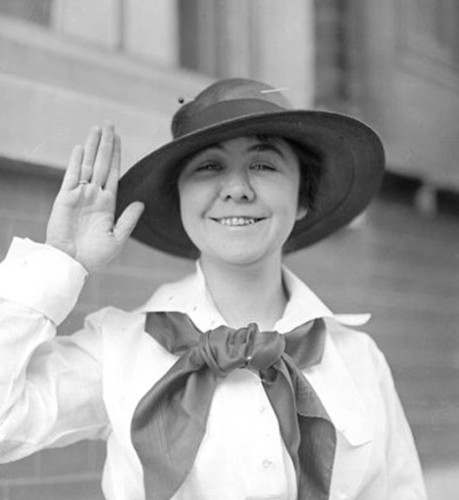Navy History Matters: Loretta Perfectus Walsh
Published: 21 March 2023
By Brent Hunt
via the Naval History and Heritage Command web site

Loretta Perfectus Walsh was the Navy’s first female chief petty officer.
On March 21, 1917, Loretta Perfectus Walsh was sworn in as a chief yeoman, becoming the first female chief petty officer in the U.S. Navy.
Four days earlier, Walsh had been the first woman to enlist in the Navy, having the distinction of being the first woman to serve in any of the U.S. armed forces other than a nursing assignment. Before Walsh enlisted, women served primarily in the medical field, but were civilian employees with few benefits. During World War I, more than 11,000 Yeoman (F) personnel—popularly referred to as Yeomanettes—served in the Navy. They primarily worked in clerical positions, received the same benefits and responsibilities as men (including identical pay of $28.75 per month), and were treated as veterans after the war. When the “Great War” ended, Walsh and all Yeoman (F) personnel were released from active duty. When Walsh joined the Naval Reserve for a four-year enlistment, she continued on inactive reserve status, receiving a modest retainer pay, until the end of her enlistment on March 17, 1921.
In the spring of 1917, the United States began preparing for the inevitable—war in Europe. However, men had not been enlisting in sufficient numbers. Secretary of the Navy Josephus Daniels determined that women could be enrolled in the U.S. Naval Reserve Force as part of the Naval Act of 1916 and issued an order authorizing their enlistment. In an attempt to prompt more men to enlist, Lt. Cmdr. Frederick R. Payne received permission to swear in Walsh as a chief petty officer in a public setting. Walsh donned a modified chief petty officer’s uniform, and the event was covered by Philadelphia newspapers. The ceremony was eventually picked up nationwide. Reporters were told of the necessity to enlist women because not enough men were enlisting. The ploy worked and shortly thereafter, before the declaration of war, the enlistment of men and women dramatically increased.

Sailors from Constitution stand next to Perfectus, a 24-pound long gun named to honor the Navy’s first chief petty officer Loretta Perfectus Walsh.
Born on April 22, 1896, in Olyphant, Pennsylvania, Walsh attended St. Patrick’s Parochial & High Schools in Olyphant and Scranton & Lackawanna Business College in Scranton, Pennsylvania. After graduating from business school, Walsh went to work as a clerk for the Navy League in Philadelphia. Walsh worked for Lt. Cmdr. Payne’s wife in the women’s section of the Navy League for Preparedness. After she enlisted and was assigned to the Philadelphia Naval Home, Walsh volunteered to work during the peak of the influenza epidemic in 1918. Walsh fell victim to influenza in the fall of 1918 and later contracted tuberculosis. She died on Aug. 16, 1925, at the age of 29 in Olyphant, due to complications of the latter disease. She is buried in St. Patrick’s Cemetery in Olyphant.
In 1928, the National Yeoman F (NYF) society of female Navy veterans of World War I was incorporated “for patriotic, historical, and educational purposes….” In 1934, the NYF began a campaign to have Walsh’s remains buried at Arlington National Cemetery and have a monument erected. In addition, an area would be set aside for the future graves of female veterans of World War I. However, their attempts ultimately failed. Instead, funds were raised by the NYF and other veterans’ organizations for a monument that was dedicated at Walsh’s grave site in 1937. Although the NYF no longer exists, the monument for the Navy women of World War I still stands today. In addition, on March 21, 2021, the world’s oldest commissioned warship afloat, Constitution, named one of its 24-pound long guns “Perfectus” to honor the first female citizen-sailor during a ceremony at Charlestown Navy Yard, Massachusetts. For more on women in the U.S. Navy, visit NHHC’s website.
Read the entire article on the Naval History and Heritage Command web site here:
External Web Site Notice: This page contains information directly presented from an external source. The terms and conditions of this page may not be the same as those of this website. Click here to read the full disclaimer notice for external web sites. Thank you.



